Exploring Barcelona’s Gothic Quarter Walking Tour: Our Experience with the GPSMyCity app
Our visit to Barcelona was very short, just three nights passing through on our way from Portugal to England. We arrived late Tuesday night, spent Wednesday marveling at La Sagrada Familia and its surroundings, and devoted Thursday to using the GPSMyCity app to do the Barcelona Gothic Quarter Walking Tour. It was the perfect way to enjoy a nearly free guided walking tour of Barcelona, with a blend of history, stunning architecture, and a touch of adventure.
Introduction to the Gothic Quarter
The Barcelona Gothic Quarter offers a glimpse into the city’s oldest roots, with streets that still echo their Roman origins. Its narrow, winding alleys are mostly closed to cars, making it easy to wander and soak in the mix of medieval charm and modern life. You’ll find a little bit of everything here—historical landmarks, local boutiques, cozy coffee shops, and architecture that tells a story at every turn.
Using the GPSMyCity app for a self-guided walking tour allowed us to navigate the maze-like streets and uncover details we might have missed otherwise. As full-time travelers, we’re no strangers to self-guided tours, and this one stood out for how it balances historical highlights with hidden gems. From the towering spires of the Barcelona Cathedral to tucked-away spots like Saint Philip Neri Square, the Gothic Quarter is a perfect way to experience Barcelona’s layers of history while keeping costs down.
The app suggested the walking tour of Barcelona’s Gothic Quarter would take about 2 hours and cover 1.1 miles. For us, it turned into an extended 4-hour trek (blame the lunch break and starting/ending a bit off-route), totaling over 3 miles.
Why the Gothic Quarter is a Must-Visit
This self-guided tour is a great way to explore the district’s highlights, from the towering spires of the Barcelona Cathedral to tucked-away spots like Saint Philip Neri Square. Whether you’re interested in history, people-watching, or just seeing a different side of Barcelona, the Gothic Quarter is worth the visit. With centuries-old buildings and hidden corners, it’s one of those places where you might get lost but still feel like you’re exactly where you’re supposed to be.
A Brief History of the Gothic Quarter
The Barcelona Gothic Quarter is the city’s oldest neighborhood, with roots stretching back to the Roman era. Around 15 BC, the Romans established a small settlement here called Barcino, and you can still spot remnants of the ancient walls and columns tucked between medieval buildings. Over the centuries, the area evolved into the heart of medieval Barcelona, with narrow streets, Gothic cathedrals, and bustling squares replacing the Roman grid.
During the Middle Ages, this district was the political and religious center of the city, home to the Barcelona Cathedral and the royal palaces. By the 19th and early 20th centuries, much of the area fell into disrepair until a restoration movement brought it back to life, creating the vibrant mix of old and new you see today. Wandering these streets, you’ll encounter layers of history—Roman, medieval, and modern—all blending into one fascinating story.
Our Review of the Barcelona Gothic Quarter Walking Tour
Barcelona’s Gothic Quarter Tour Highlights
- Catedral de Barcelona (Barcelona Cathedral)
- Placa Nova (New Square)
- Casa de l’Ardiaca (Archdeacon’s House)
- Museu Frederic Mares (Frederic Mares Museum)
- Palau del Lloctinent (Lieutenant’s Palace)
- Placa del Rei (King’s Square)
- Capella Reial de Santa Agata (Royal Chapel of St. Agatha)
- Placa Sant Just (St. Justus Square)
- Placa de Sant Jaume (St. James’s Square)
- Temple d’August – MUHBA (Temple of Augustus)
- Pont del Bisbe (Bishop’s Bridge)
- Palau de la Generalitat (Palace of the Generalitat)
- Placa de Sant Felip Neri (St. Philip Neri Square)
- Basilica de Santa Maria del Pi (Basilica of St. Mary of the Pine)
- Placa de Sant Josep Oriol (St. Joseph Oriol Square)
The walk starts at

Catedral de Barcelona / Barcelona Cathedral (Must See)
The Barcelona Cathedral, or Cathedral of the Holy Cross and Saint Eulalia, is a must-see for its rich history and architectural beauty. Built between the 13th and 15th centuries, this Gothic masterpiece houses the relics of Saint Eulalia and features unique touches like 13 geese in the cloister, symbolizing her age at the time of her death.
Don’t miss the rooftop terrace for stunning city views and a closer look at the cathedral’s intricate towers and pinnacles. Whether you’re drawn to its serene cloister, historical artifacts, or breathtaking design, the Barcelona Cathedral offers a peaceful contrast to the city’s busier attractions.
This is one of the more impressive looking cathedrals we’ve visited in all of our travels so far but we were limited on how much time we could spend in this city so we’ll definitely make time for a proper tour of the inside if we come back to Barcelona in the future.
From there, it’s a short walk to
Plaça Nova / New Square

Well, I mean, ‘new’ is relative, right? It was new when it was established as a marketplace in the 1350’s. Bishop’s Palace and remnants of a roman wall are highlights of this oldest square in the city, which coincidentally is kind of triangular in shape rather than a square. Tip: Each Thursday, from 9 am to 8 pm, New Square hosts an antiques market.
Next up, and one of the places we spent significant time at was
Casa de l’Ardiaca / Archdeacons House

There is a crazy amount to take in here. From the tile on the ground floor to the archways and the railings on the mezzanine, it’s worth slowing down to explore this place. There are a few interesting architectural details outside the building so be sure to take a moment and appreciate the level of detail that went into the construction


The next landmark on the GPSMyCity Gothic Quarter walk, which we only passed by (since this was not a day for in-depth exploration) is
Museu de Frederic Mares / Frederic Mares Museum
This art and sculpture museum is another place we would put on the list to visit on a return trip. Thousands of pieces spanning the 12th to 19th centuries? Yup. That’s right up our alley


This museum contains pieces made by and collected by Frederic Mares a distinguished 20th-century sculptor and collector. The Frederic Marès Museum is a treasure trove of art and history formerly housed within the former Royal Palace of the Counts of Barcelona. Established in 1948, the museum has grown from a modest exhibition of Frederic Marès’s own collection into a profound cultural landmark.
Next up on the walk, and another long stop for us, was
Palau del Lloctinent / Lieutenants house
And by ‘Lieutenant’ they actually mean ‘Viceroy’; essentially the King’s Lieutenant, not a military rank. This is an incredible building. You know we’re into architecture as attraction, right? We spend a lot of time looking at buildings everywhere we go. Windows, doors, columns, all of it.

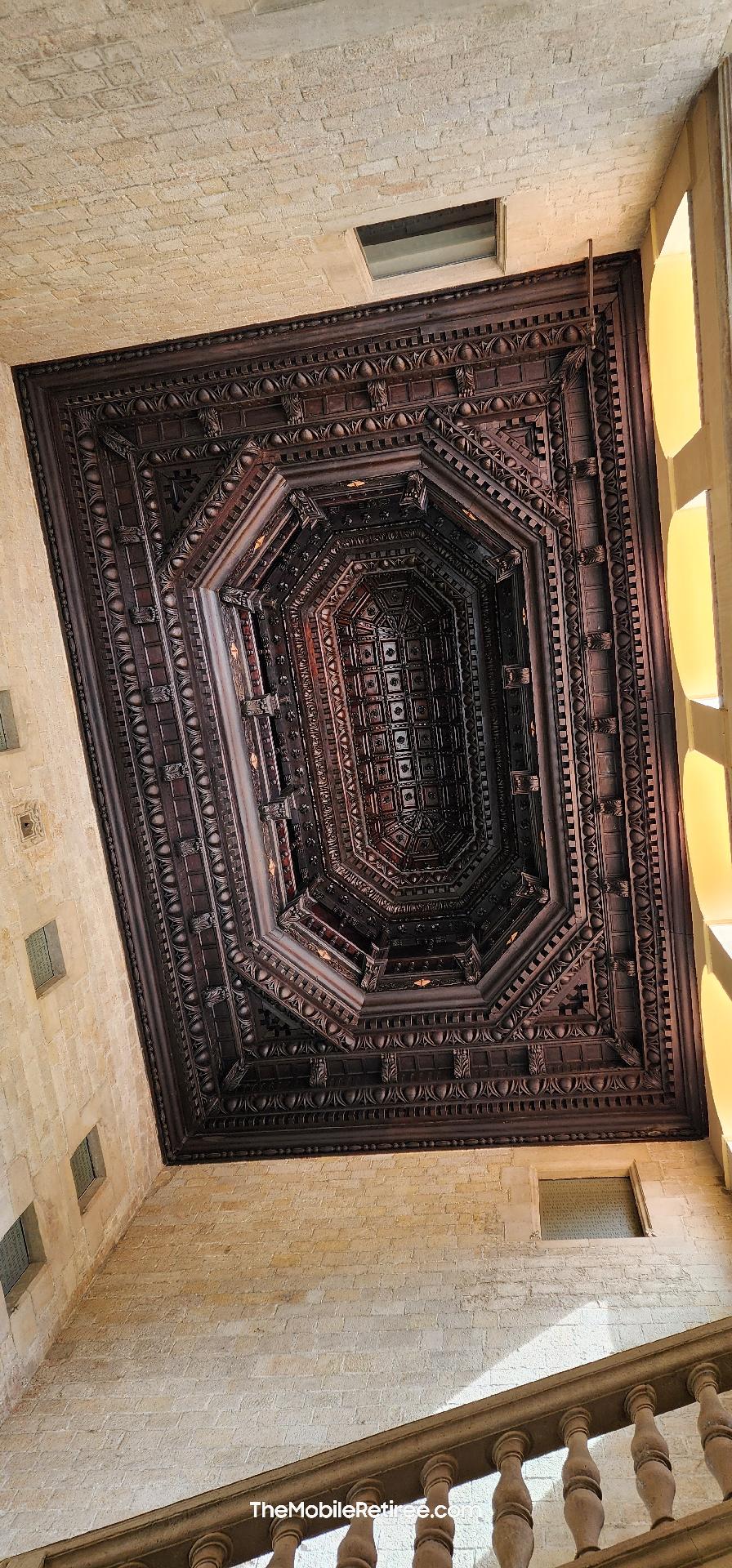
This 17th century building features a gorgeous courtyard and an amazing carved wooden ceiling. The ground floor courtyard also features some interesting tilework.
From there we move to
Plaça del Rei / Kings Square and Capella Reial de Santa Àgata / Royal Chapel of Saint Agatha


King’s Square is a bit humdrum if you’ve seen a lot of squares. And if you’ve spent much time in Europe, you’ve probably seen a lot of squares. The architecture is beautiful but the Chapel of St Agatha really steals the show

If you happen to visit on the hour, you’ll hear the bells toll across the area.
After King’s Square, we head to
Plaça de Sant Just / St Justus Square


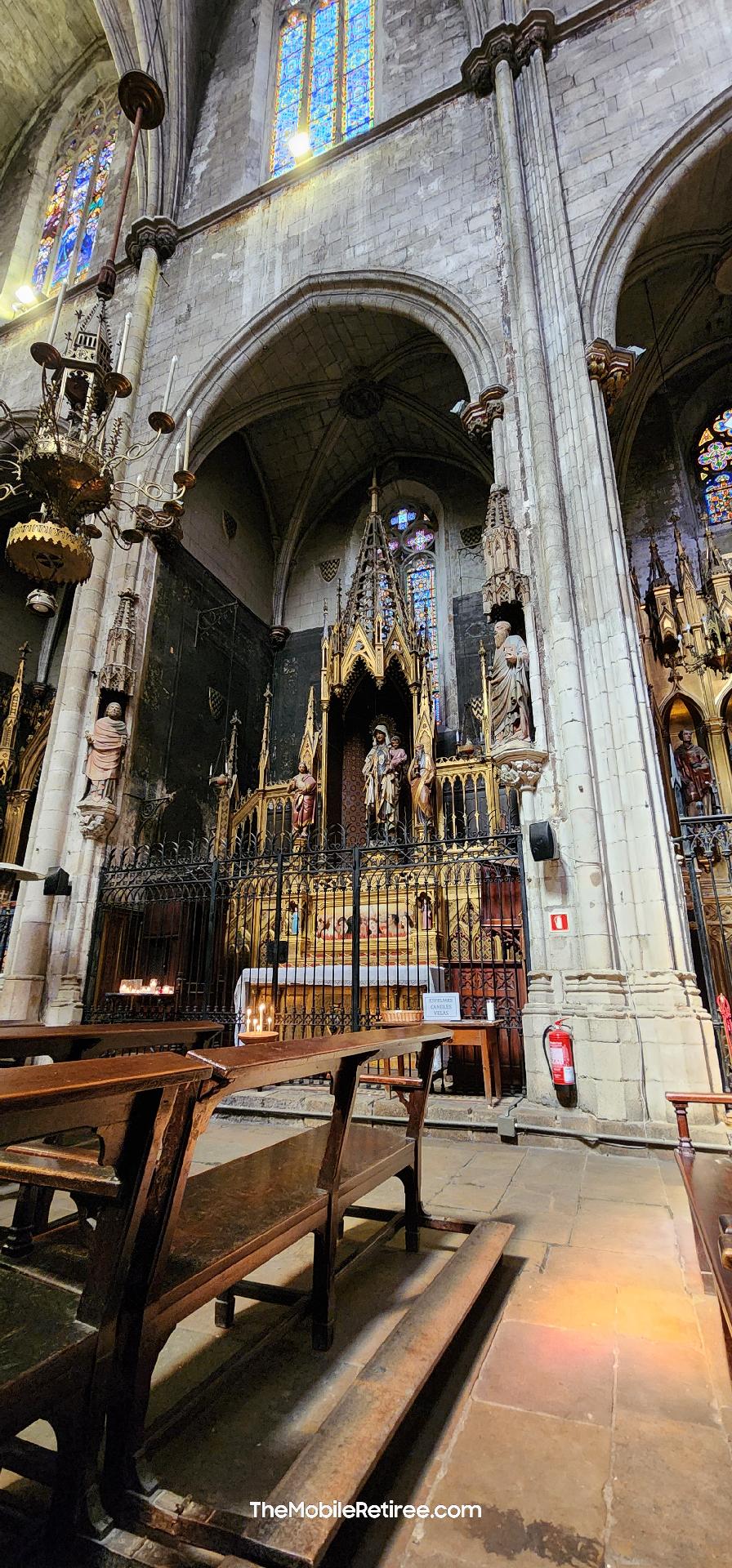
More a junction than a square in our opinion, it is surrounded by impressive buildings. The Gothic Quarter of Barcelona feels like a series of squares and plazas connected by a network of narrow alleys and streets
One of the more imposing squares is coming next
Plaça de Sant Jaume / St James’s Square and Palau de la Generalitat de Catalunya / Presidential Palace
This square is massive and dominated by the Presidential Palace on one side and city hall on the other. When we visited, there was a protest going on in the square. Well, it was one really loud guy protesting but, still, a public protest all the same.

As far as landmarks go, this part was a bit confusing on the app. These were items 9 and 12 so you look at the square, go around the back of the Presidential Palace to visit the next two items then come back to the square to look at the Presidential Palace. I haven’t updated the app, maybe they’ve changed the route for this one.

As you wander St James’s square, remember to keep a sharp eye out for vehicular traffic crossing through. Much of the Gothic Quarter is pedestrianized so you may get lulled into a false sense of security.
Dialing the wayback machine to ‘Roman Temples’, we head next to
Templo de Augusto / Temple of Augustus

There is a tremendous amount of information available in this museum and it’s also, if not crowded, a good place to sit and contemplate for a few minutes. The columns were discovered by accident in the 19th century. Three of the columns stand on their original spots, a 4th was displayed in King’s Square until the 1950’s then moved inside

Now we head to the back of the Presidential Palace to find
Pont del Bisbe / Bishop’s Bridge
There are a few of these bridges in the gothic quarter, most aren’t called out specifically as landmarks, they’re just there. Most of them aren’t quite as fancy as the Bishop’s bridge, either. Pont del Bisbe is as much decorative as it is functional

Our next landmark is a reminder of slightly more recent historical events
Plaça de Sant Felip Neri / Sant Felip Neri Square
This square is primarily noteworthy for it’s pock-marked walls. During the Spanish Civil War a bomb in the square killed 42 people; mostly women and children. The damage to the walls serves as a tragic reminder to the cost of war

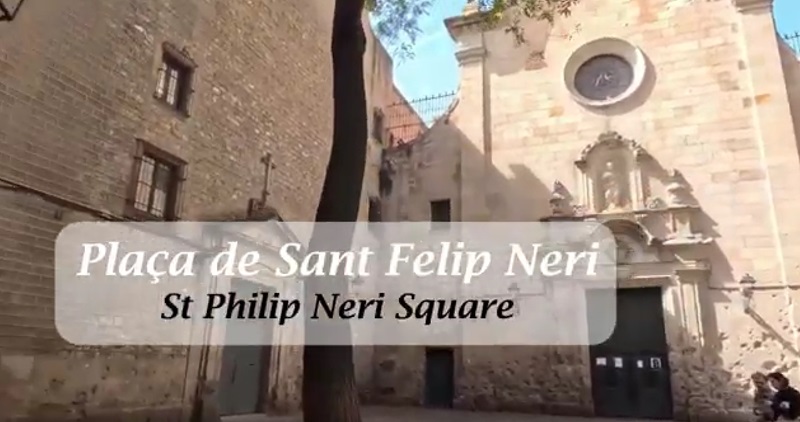
A little further on we come to yet another example of the complexity of gothic architecture
Basílica de Santa Maria del Pi / Basilica of Santa Maria del Pino
Frequently listed as a 15th century gothic church, that really is the date for the bell tower. The main church building predates that although it was damaged by earthquake and restored in the 15th century. This basilica is known primarily for its stained glass and large ‘rose’ window. It is also one of just a few where visitors can climb the bell tower.

The final landmark on the GPSMyCIty Gothic Quarter walk is
Plaça de Sant Josep Oriol / St Josep Oriol Square
One of three squares surrounding Santa Maria del Pino, this one is planted with trees rather than being a simple open space

What We Loved About the GPSMyCity Tour
The routing of the walk on the app was curious to us as you do double back on yourself; pretty sure we walked past the back of Barcelona Cathedral a total of 3 times and also through or past St James’s Square an equal number of times. Part of the challenge may have been with our navigation but the order that items are listed will require some retracing of steps but perhaps they structured it that way because there is so much to see.
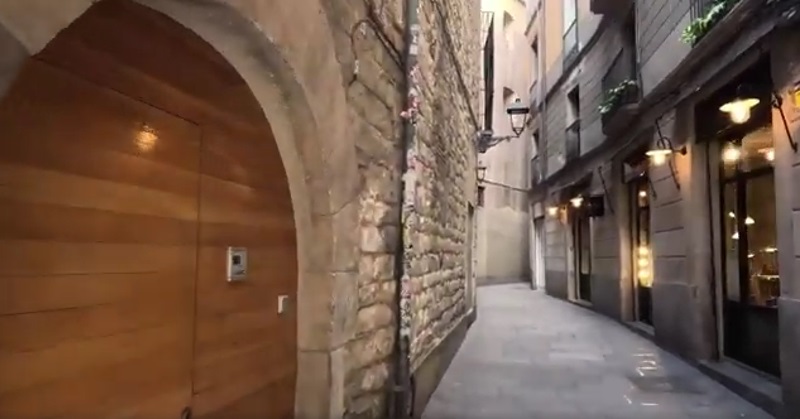
Along the way we came across many other beautiful buildings, some impressive street art and narrow streets ranging from crowded and bustling with activity to eerily quiet.
Note: You can download the app for free and get access to many of the articles and walking tours. But if you want to use the maps offline then you do need to pay but it’s not a lot and it’s usually worth it to avoid the roaming fees and for the convenience of having all the details there on your phone. Also note that the app uses a lot of battery power so be sure to bring a backup battery pack with you on the walk!

Renovation and reconstruction are simple facts of life for the gothic quarter. Although many of the present buildings date to the 13th and 14th century, they were often built on top of 4th and 5th century buildings.



Artistic expression is everywhere – from tiles and frescoes to statuary and modern street art
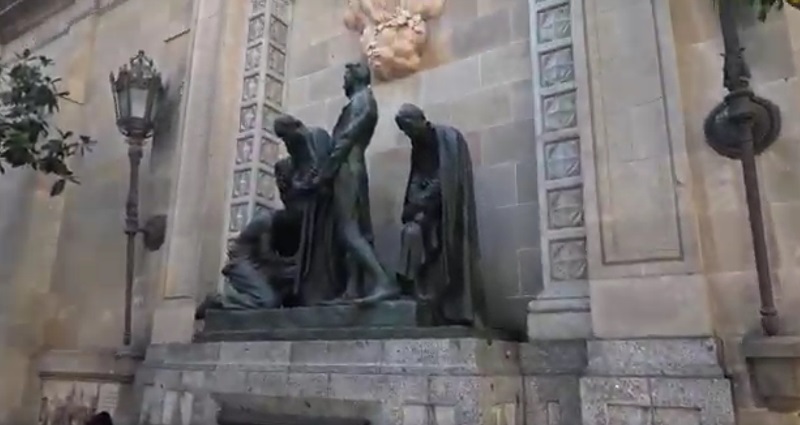
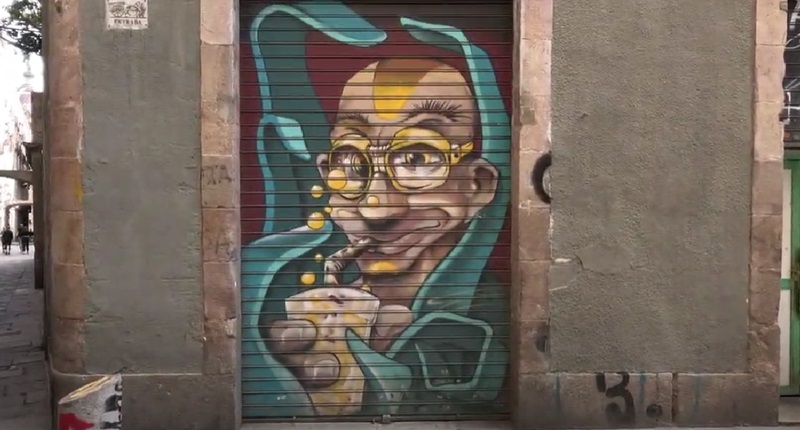
The Gothic Quarter is not exclusively gothic architecture. Having been built up over a period of centuries, examples of other styles are everywhere. Greek, Roman, neo-Classical are all interspersed along the streets and squares


Even the backs of buildings are impressive in this area. We didn’t make a location note at the time but according to Google Image Search, this is the back of the city hall building.

Wrapping it all up
Barcelona was on our list of cities to possibly do an extended stay in. Not high on the list as it is a huge, and touristy city, but we wanted to stop in for a short visit and get a sense of how the city worked. The transit system seems to be good, we were able to get around pretty easily but, to be fair, the first day we only walked so, getting from the area of La Sagrada Familia down to the Gothic Quarter isn’t really a great test. Moving from one tourist attraction to another is easy in most large cities.
There is a chance we will return to Barcelona and if we do there are for sure a couple of things in the Gothic Quarter we’ll explore more fully. Since Barcelona is getting a reputation for becoming very anti-tourist and it’s also the only place I’ve been targeted by pickpockets, we aren’t in a real rush. Toledo, Sevilla and Valencia are also on our list for exploration so when we return to Spain there will have to be some decisions made about which areas actually rank.
Another important consideration for us, and probably not for most travelers, is that we are exploring mostly places we feel like we could someday settle down. We’re hitting some other places just because we want to see them and Barcelona is part of that group.
Quick Facts
How long does it take to explore Gothic Quarter Barcelona?
The app suggested the walking tour of the Gothic Quarter would take about 2 hours and cover 1.1 miles. For us, it turned into an extended 4-hour trek (blame the lunch break and starting/ending a bit off-route), totaling over 3 miles.
Is it good to stay in the Gothic Quarter Barcelona?
If you’re short on time and have a fairly flexible budget staying in the Gothic Quarter (Barri Gòtic) in Barcelona can be a great choice for travelers looking for a quintessential Barcelona experience. This 5 Star boutique hotel might just be the luxury place you’re looking for!
What should I bring?
During the summer it can get very hot so don’t forget your sunglasses, sun-tan lotion and a bottle of water. Although the temperatures in Barcelona are mild for most of the year, in winter it can be cold so dress accordingly. You will also need to cover your shoulders and wear clothing that goes beneath your knee if you would like to visit the Cathedral cloister.
How is accessibility? Is the Gothic Quarter sights wheelchair friendly?
For the most part, yes. There are a couple of small inclines but we didn’t notice any significant obstructions other than if you visit the Roman Temple, there is a small ledge that leads into the hallway of the house but from this area you can still view the columns.



